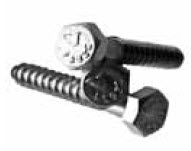
When shopping for fasteners, you may come across hex lag screws. They are commonly used in construction and other woodworking applications. Like other types of screws, hex lag screws have external threading that’s able to dig into wooden workpieces. Hex lag screws, however, feature a unique design that distinguishes them from other types of screws. To learn more about hex lag screws, keep reading.
Overview of Hex Lag Screws
Hex lag screws are coarsely threaded fasteners that feature a hexagonal head and a sharp tip. A hexagonal head is a defining characteristic of hex lag screws. Other types of screws often have a recessed head. Some of them have a flat-head recess, whereas others have a Philips head recess. Hex lag screws are distinguished from these traditional fasteners by featuring a hexagonal head.
Another defining feature of hex lag is coarse threading. Coarse threading means there are fewer threads per axial distance. It’s essentially the opposite of fine threading. Screws with fine threading have more threads per axial distance. Hex lag screws are specifically designed with a hexagonal head and coarse threading.
Benefits of Hex Lag Screws
Hex lag screws offer several benefits. With their hexagonal head, they are easier to install than traditional screws with a recessed head. You can easily drive a hex lag screw into a wooden workpiece by using a socket wrench. Socket wrenches are available with hex sockets that accommodate the hexagonal head of these screws.
When compared to other types of screws, hex lag screws often offer a strong hold. This is why they are used in construction and woodworking applications. Wooden workpieces require strong and secure fasteners. If a fastener has a weak hold, it may come out. Hex lag screws have coarse threading that’s able to grip the interior of wooden workpieces. The end result is a strong hold that prevents them from coming out
You can find hex lag screws in different materials. Carbon steel is one of the most common materials in which they are made. Carbon steel hex lags screws are exceptionally strong and durable. Other hex lag screws are made of stainless steel. Stainless steel hex lag screws aren’t as strong as those made of carbon steel. Nonetheless, they offer a higher level of protection against rust and corrosion. If you’re planning to use them in a humid or moist environment, you may want to choose stainless steel hex lag screws.
